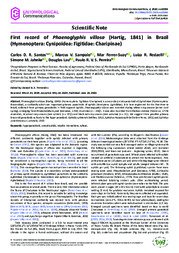First record of Phaenoglyphis villosa (Hartig, 1841) in Brazil (Hymenoptera: Cynipoidea: Figitidae: Charipinae).
First record of Phaenoglyphis villosa (Hartig, 1841) in Brazil (Hymenoptera: Cynipoidea: Figitidae: Charipinae).
Author(s): SANTOS, C. D. R.; SAMPAIO, M. V.; FERRER-SUAY, M.; JAHNKE, S. M.; LAU, D.; PEREIRA, P. R. V. da S.
Summary: Abstract. Phaenoglyphis villosa (Hartig, 1841) (Hymenoptera: Figitidae: Charipinae) is a secondary endoparasitoid of Aphidiinae (Hymenoptera: Braconidae), a subfamily which are important primary parasitoids of aphids (Hemiptera: Aphididae). It is here registered for the first time in Brazil, collected from primary parasitoids in field-exposed aphids. Phaenoglyphis villosa was recorded during wheat crop season (winter and spring), emerging from Rhopalosiphum padi (Linnaeus, 1758) mummies (n = 35♀). It was also recorded from Sitobion avenae (Fabricius, 1775) mummies, in wheat crop season (late winter) (n = 13♀) and black oat crop season (late autumn) (n = 1♀). We suggest three possible primary braconid parasitoids as hosts to this hyperparasitoid: Aphidius platensis Brèthes, 1913, Aphidius rhopalosiphi de Stefani- Perez, 1902, and Aphidius uzbekistanicus Luzhetzki, 1960. Keywords: hyperparasitoid, cereal aphids, trophic interactions, wheat.
Publication year: 2020
Types of publication: Journal article
Unit: Embrapa Wheat
Observation
Some of Embrapa's publications are published as ePub files. To read them, use or download one of the following free software options to your computer or mobile device. Android: Google Play Books; IOS: iBooks; Windows and Linux: Calibre.
Access other publications
Access the Agricultural Research Database (BDPA) to consult Embrapa's full library collection and records.
Visit Embrapa Bookstore to purchase books and other publications sold by Embrapa.

